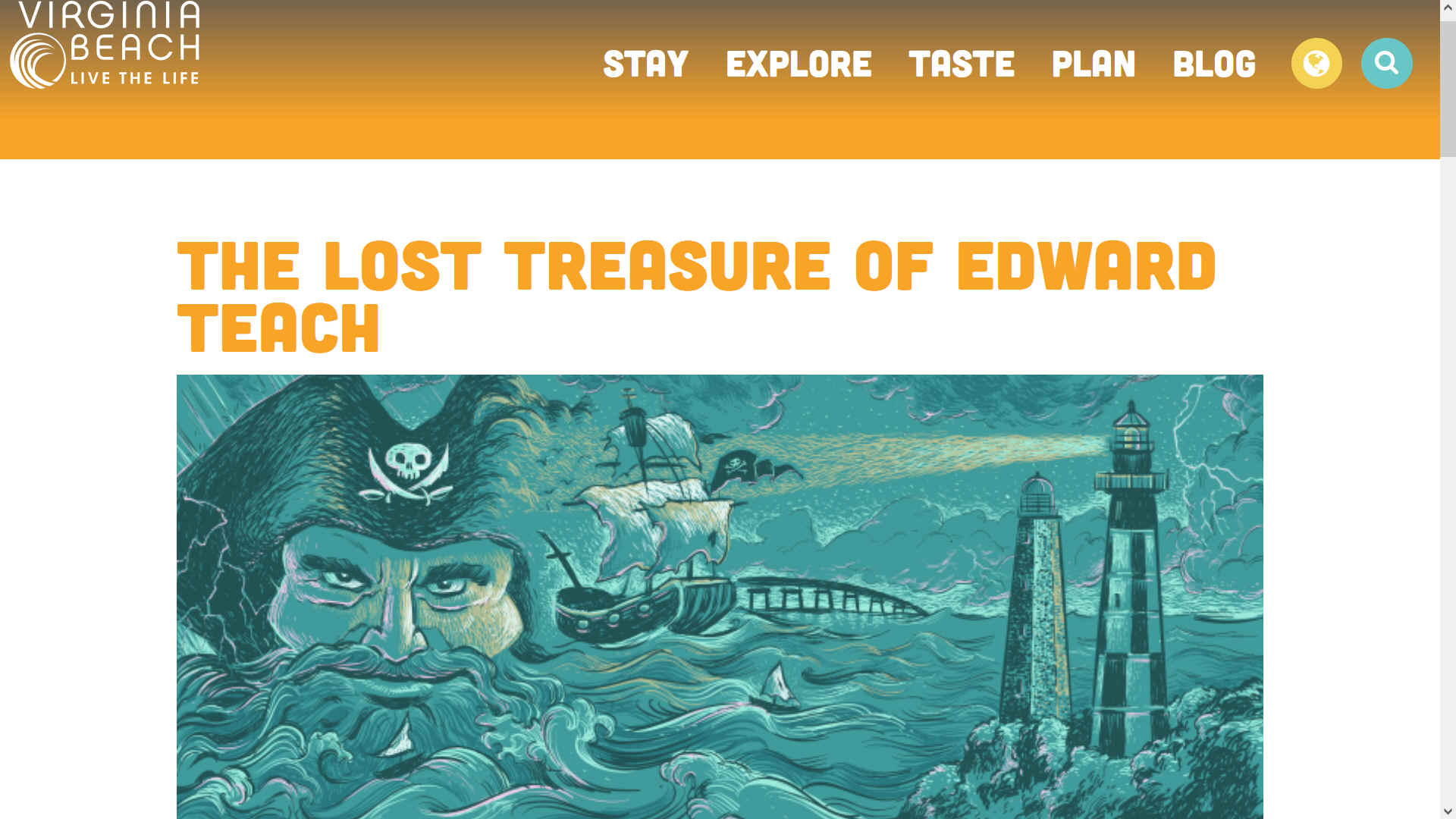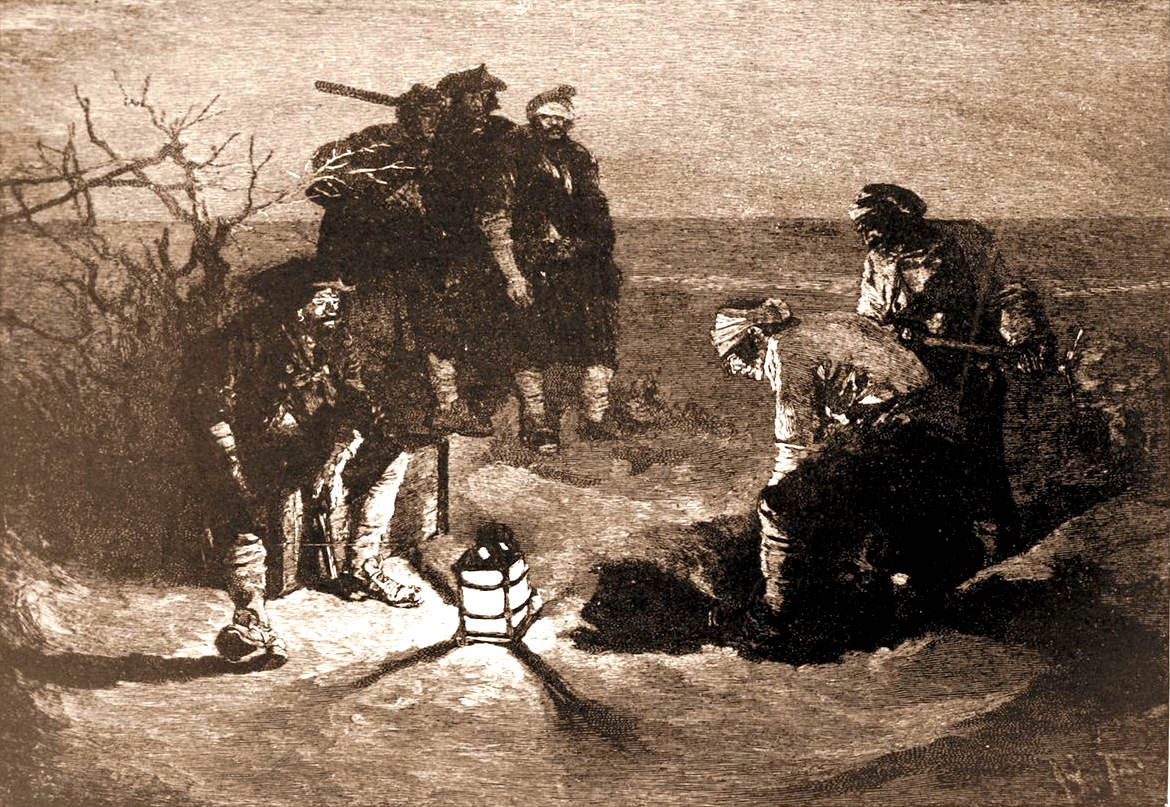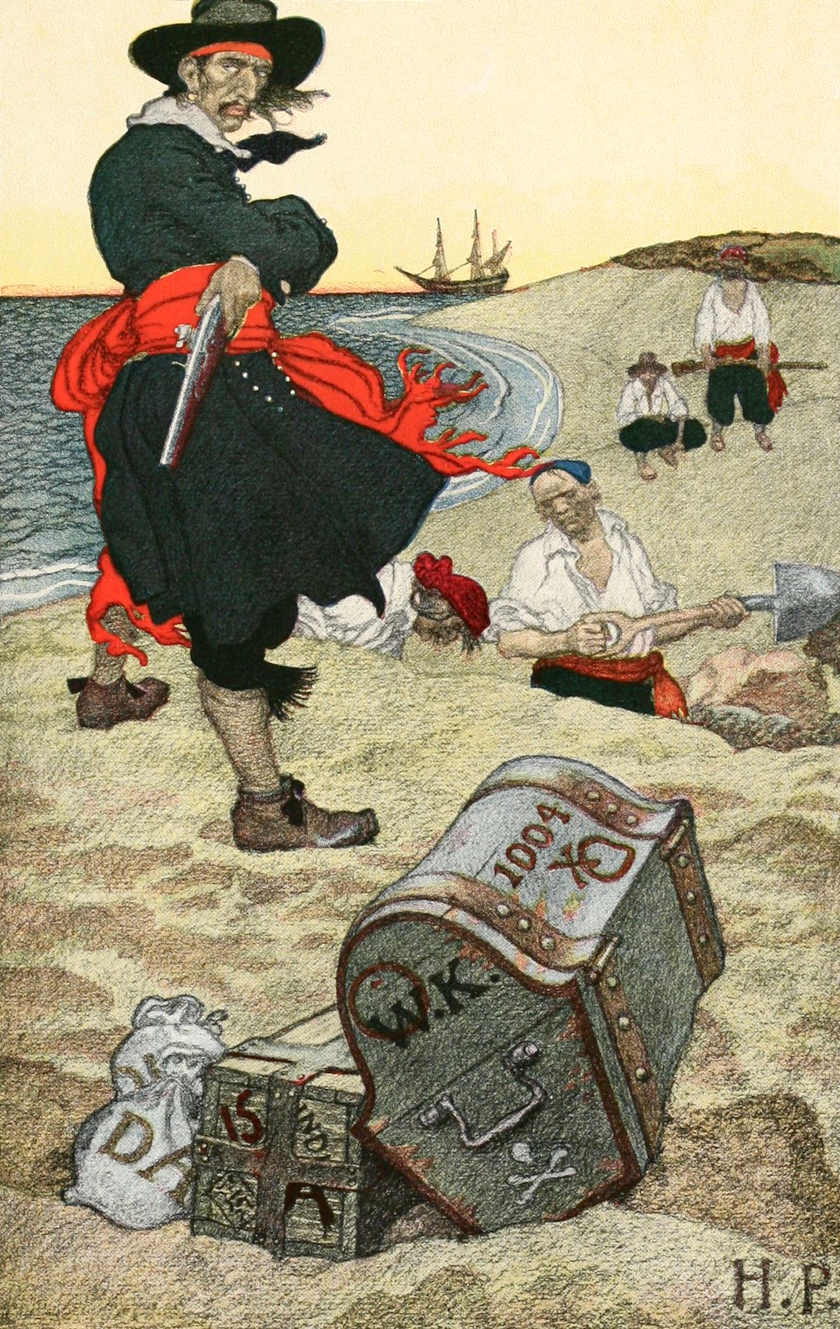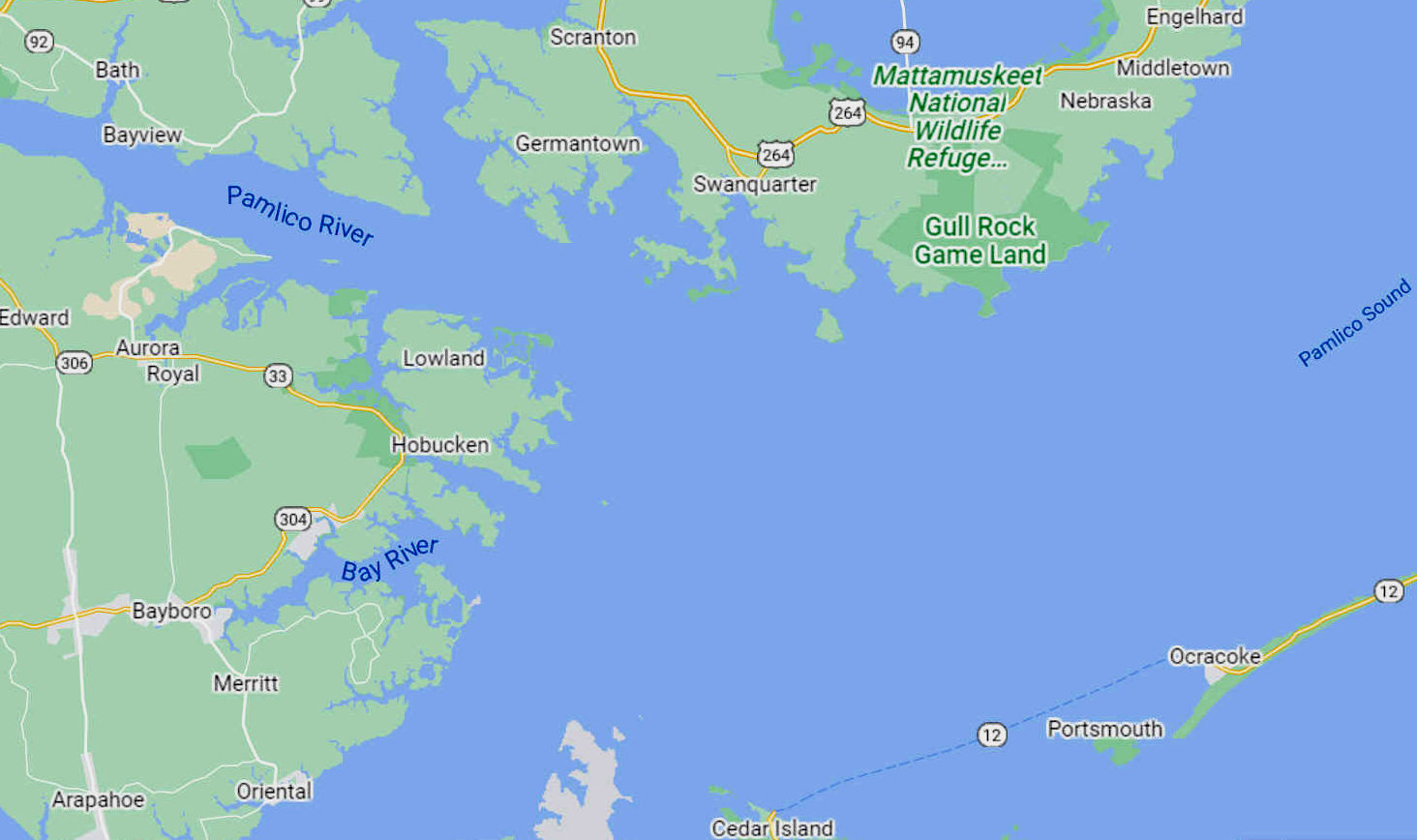|

Virginia
Beach is an improbable location for a pirate to bury treasure. The geography
is too close to where the pirating was taking place at Charleston,
hence more of a feint, to throw opportunists off the track. The real pirate
action was in the Caribbean, with special protections from Spain, for some
of the more useful mariners. Edward Teach was a threat to the British and
Colonials. More of an ally to Mexico and Columbia, where Blackbeard could
quench his appetite for women.
There had been stories for hundreds of years that Blackbeard buried a
treasure on the east coast of America — silver bars taken from an English
ship, is one of the favorite themes. But what of the gold and jewels? The
locations have included Plum Point at Bath Creek, Londoner's Island, and
Blackbeard Island, Georgia.
Blackbeard was an English-born pirate, whose real name was Edward
Teach, or Thatch, depending on which historian is consulted. He is believed to
have started as a privateer in the Spanish Succession War, fought from 1701
to 1714.
Primarily driven by a desire for access to Spanish markets in the Americas. Modern economists generally assume a constantly growing market, but the then dominant theory of Mercantilism viewed it as relatively static. Increasing one's share implied taking it from someone else, and the role of the state was to restrict foreign competition by attacking merchant ships and colonies.
In 1700, Spain remained a great power in terms of territory controlled, while recent research shows imports of bullion from the Americas actually reached their highest level between 1670 and 1700. However, this concealed major structural weaknesses; the vast majority of these imports were used to fund debt or pay foreign merchants. When the new Bourbon administration took over in 1701, they found the Empire bankrupt and effectively defenceless, with fewer than 15,000 troops in Spain itself and a navy consisting of 20 ships in total.
Almost constant warfare during the 17th century made the economy subject to long periods of low productivity and depression, and largely reliant upon others for its prosperity. In many ways, the continued existence of the Empire was not due to Spanish strength but to maintain a balance between the powers competing for a share of its markets.
The close links between war and trade meant conflict extended beyond Europe, particularly in North America, where it is known as
Queen Anne's
War, and the West Indies, which produced sugar, then a hugely profitable commodity. Also, there were minor trade conflicts in South America, India, and Asia; the financial strains of war particularly affected the Dutch East India Company, as it was a huge drain on scarce naval resources.
Finally, while colonial conflicts were relatively minor and largely confined to the North American theatre, the so-called Queen Anne's War, they were to become a key element in future wars. Meanwhile, maritime unemployment brought on by the war's end led to the third stage of the Golden Age of Piracy, as many sailors formerly employed in the navies of the warring powers turned to piracy for survival.
Dusk can be hauntingly beautiful. As the colors of the impending night descend through the Spanish moss-adorned trees, the shadows that stretch across the swamp marshes below grow longer. With the day in its final act, the autumn breeze strumming through the leaves provides an ethereal soundtrack, as the soft and steady drumroll of the Bay’s tide crescendos in the background. The diminishing light makes the ancient forest seem, somehow, even older, eliciting the feeling of a grand old house whose walls have bared witness to the triumphs and tragedies of many lifetimes, equal parts magnificent and melancholy – each with a story to tell. This is no ordinary tale, however. While the spectacle is a sight worth savoring, be warned; as the curtain closes and the lights go down, it would be wise to hurry on home as quickly as you can. This story is of the ghostly variety. Linger too long, and you might just find yourself right in the middle of it.
A walk along the Chesapeake Bay beach today, at what is now called First Landing State Park, is still very much the same as it would’ve been in the early 1700s. The windswept dunes sit pinned between the incoming tide and the bald cypress trees of the park, offering an unimpeded view of the bay. While today you can look out and see the massive silhouette of cargo ships, 300 years ago the view was of the mighty sails of merchant ships heading out to sea or Navy vessels on the hunt for pirates, making it a particularly useful lookout for one Captain Edward J. Teach - Blackbeard, himself. Teach stationed his men at Cape Henry while he enjoyed the benefits of being the boss a few miles inland at what is now aptly named Pleasure House Road. When his men would see a ship, they would signal their captain and notify him of the ship’s direction. A vessel coming from the East was typically a merchant ship ripe for the taking, while a vessel from the West was often the Royal Navy, from which the pirates would escape by setting sail through the narrow inland waterways back out to the ocean, before sailing to their stronghold in North Carolina.
One day, as the pirates were enjoying their down time at the Pleasure House, a gathering place for drinking, a signal came indicating that a merchant ship was approaching from the East. The pirates sprang to action, setting chase to the merchantmen, and soon caught up to them thanks to their boat being slowed by heavy boxes filled with valuable treasures. After taking control of the ship and the prize onboard, cannon fire in the distance alerted him to two naval vessels quickly approaching. Without much time, Blackbeard buried his treasure in the sand dunes and made haste down to his North Carolina hideout, intending to return to reclaim his gold when they were clear of the warships. It was never to be, however, as the Navy’s ships caught up with Teach in the Outer Banks. A bloody battle ensued and ended when the pirate captain was beheaded at the hands of
Lt. Robert
Maynard.
Virginia Beach is an independent city located on the southeastern coast of the Commonwealth of Virginia in the United States. The population was 459,470 as of the 2020 census. Although mostly suburban in character, it is the most populous city in Virginia, fifth-most populous city in the Mid-Atlantic, ninth-most populous city in the Southeast and the 42nd-most populous city in the U.S. Located on the Atlantic Ocean at the mouth of the Chesapeake Bay, Virginia Beach is the largest city in the Hampton Roads metropolitan area. This area, known as "America's First Region", also includes the independent cities of Chesapeake, Hampton, Newport News, Norfolk, Portsmouth, and Suffolk, as well as other smaller cities, counties, and towns of Hampton Roads.
Virginia Beach is a resort city with miles of beaches and hundreds of hotels, motels, and restaurants along its oceanfront. Every year the city hosts the East Coast Surfing Championships as well as the North American Sand Soccer Championship, a beach soccer tournament. It is also home to several state parks, several long-protected beach areas, military bases, a number of large corporations, Virginia Wesleyan University and Regent University, the international headquarters and site of the television broadcast studios for Christian Broadcasting Network (CBN), Edgar Cayce's Association for Research and Enlightenment, and numerous historic sites. Near the point where the Chesapeake Bay and the Atlantic Ocean meet, Cape Henry was the site of the first landing of the English colonists, who eventually settled in Jamestown, on April 26, 1607.
The city is listed in the Guinness Book of Records as having the longest pleasure beach in the world. It is located at the southern end of the Chesapeake Bay Bridge-Tunnel, which was the world's longest bridge-tunnel complex until the Hong Kong-Zhuhai-Macau Bridge opened in 2018.
Location
map
Each time Disney releases another pirate blockbuster film, locals are asked
where did
Blackbeard
bury his booty.
What do you think about the Blackbeard
story? It's a good story. But it ain’t history."

Edward Teach, known more popularly as Blackbeard, sailed to the Carolinas
where he blockaded Charleston with several ships and 700 men, was pardoned by the king, then settled down in Bath, North Carolina with Mary Ormond - the 14th Mrs. Blackbeard. Teach was betrayed by a southern governor who had been sharing in his booty.
The pirate died with 20 knife and five gunshot wounds soon after, the
betrayal.

SKELETON
ISLAND - Sir Henry Morgan
visited this island on many occasions, though his plantations were in
Jamaica, and he lived in Port Royal, where he enjoyed the high life. On some
pirate parchments Blackbeard's Cove is marked. On modern maps only Morgan's
Head is acknowledged - simply because Edward Teach did not manage to retire,
pardoned, but cut off in his prime. Today we know the above as Isla
de Providencia, Columbia.
THE
BATTLE OF OCRACOKE 22ND NOVEMBER 1718
It began within minutes after the notorious pirate Blackbeard was killed in the Battle at Ocracoke on Saturday morning, November 22nd 1718.
As soon as the wounded were attended to and the surviving pirates were placed under guard, the hunt was on, led by Royal Navy
Lieutenant Robert
Maynard. The first place they searched was Blackbeard’s cabin in the roundhouse of his 65-foot-long Jamaica-rigged sloop, Adventure. Surely the world’s best-known and most-feared pirate captain kept a chest of Spanish gold, silver and jewels hidden beneath his bunk, just for his walkin’ around money.
Rarely mentioned in the many books, articles and other accounts of the famous battle is that Maynard and the other volunteer sailors from the British king’s ships stationed in Virginia were persuaded to accept the potentially deadly assignment of apprehending or killing the North Carolina pirates by the prospect of acquiring pirate treasure. It could be said that the 60 men aboard the two, small, rented sloops under Maynard’s command were little more than pirates themselves.
Maynard’s stay at Ocracoke may have been when an enduring Blackbeard myth was born. While nine captive pirates were held in the lower deck of the Adventure while anchored in the yet-to-be-named Teach’s Hole Channel, a guard may have asked them,
so, where did the boss hide his treasure? Funny you should ask, a pirate replied, we posed that question to him just last night.
The published version of the interrogation in a 1724 book, ”A General History of Pirates,” goes like this: “… one of his Men asked him, in Case any thing should happen to him in the Engagement with the Sloops, whether his Wife knew where he had buried his Money? He answered, That no Body but himself and the Devil, knew where it was, and the longest Liver should take it all.”
At the end of the two weeks at Ocracoke, Maynard sailed Blackbeard’s ship
'Adventure' across Pamlico Sound and up to Bath, but not with the pirate’s head hanging under the bowsprit as is so often told – it was too valuable, worth a bounty of 100 pounds sterling back in Virginia.

We
are asked to believe that Edward Thatch, was not a successful, or wealthy pirate.
But given his years as a privateer, then pirate, one wonders what happened
to all of the booty he purloined.
Compare Blackbeard’s final estate to Capt. William
Kidd’s £14,000 worth of gold,
silver, and
jewels; or the East Indian pirate Henry Every’s much more impressive £350,000 haul; or Sam Bellamy’s estimated plunder of as much as a million pounds sterling. But that all ranks well below
Sir Francis
Drake’s massive piratical treasure of £1.5 million valued in 1582. Yes, Drake was the greatest pirate of them all.

https://www.visitvirginiabeach.com/blog/post/vabeach-haunts-the-lost-treasure-of-edward-teach/

A
map showing Charleston, the city Blackbeard blockaded, leading to the drive
to capture the pirate. Given that Bath River is just some 500km north, it is
reasonable to assume that he had a buyer for the goods he was trading, confiscated
from his victims. His trades would surely have been converted to gold or
silver, the only reliable transportable currency of the day.

Map
showing Bath River and Plum Point, leading into Pamlico River. Ocracoke and
Portsmouth is shown with Pamlico Sound. Given that these are two locations
documented as involving Blackbeard, and with his piratical target being so
close, there must have been another location where the pirate felt safe
banking his stash, that his American cousins would not twig.
|





